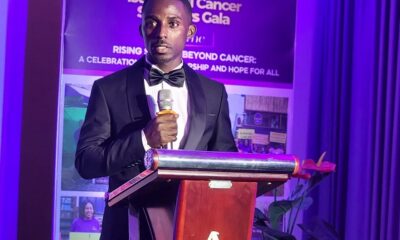Features
Preventing fire disasters
Published
2 months agoon
I got a phone call a couple of weeks ago and when I picked up my phone to see who was calling me, I saw it was my sister. When I responded, I heard to my surprise the voice of my brother-in-law who had returned to Ghana and was calling to say hello.
This man’s voice immediately reminded me of the June 3 fire disaster near Kwame Nkrumah Circle. It was just by God’s grace that he escaped that unfortunate incident that has severely impacted many lives in the country.
I recently watched a heart wrenching spectacle of a woman wailing uncontrollably on TV, because of the calamity that has befallen her as a result of a fire disaster. When interviewed, her predicament was revealed regarding how she was going to pay for a loan she had just contracted when the stock of items she had invested the funds in, had all been destroyed by fire.
Still on the subject of suffering as a result of fire disasters, I could hardly hold my tears as I heard the moanings of agony from a patient who had received severe burns covering almost 90 per cent of his body.
It was indeed a terrible sight and it reminded me of another fire disaster that led to the burning to death of a former work colleague when his house caught fire. A policy of dealing with fire disaster prevention, must be established immediately or the existing ones improved to take care of the current challenges of fire disasters.
As someone who comes from an industry where safety cannot be compromised, I take special interest in safety issues. Watching the news on TV last week, a nurse narrated how most of the burns cases that were brought to the hospital involved children, who were burned as a result of hot water splashing on someone through horse play, fighting etc.
These are cases that could have been avoided, if parents had been a bit more careful in taking care of their children. Apart from the pain that patients suffering from burns endure, the psychological trauma that the scars resulting from their injuries creates, in some instances, they cause mental challenges like schizophrenia, suicidal tendencies etc. What has to be done to prevent fire disasters must seriously engage the attention of policy makers.
An educational drive of fire prevention must be established so every Ghanaian will begin to appreciate the hazard fire poses and what can be done to prevent fires in our homes, workplace, schools, offices etc.
This education must start from the kindergarten level right up to the tertiary level. The good book says train a child the way he should go and when he grows, he will not depart from it. Government organisations like the Information Services Department under the Ministry of Information and Nation Commission for Civic Education (NCCE) as well as National Disaster Management Organisation (NADMO), should be encouraged to execute a concerted effort to ensure a successful educational programme for fire prevention.
The first thing that needs to be done is to implement enforcement of fire extinguishers being present in every house, being of the right type and the right capacity. Basic things like switching off the main power source in the event of electrical fire in the house must be taught.
I believe the outreach programme should involve churches, various women groups, various departments and organisations both private and public and finally various associations.
NB: ‘CHANGE KOTOKA INTERNATIONAL AIRPORT TO KOFI BAAKO INTERNATIONAL AIRPORT’
You may like
In Ghana, the Narcotics Control Commission Act, 2020 (Act 1019), prohibits the possession, use, trade, or cultivation of narcotic drugs without lawful authorisation.
The law now adopts a more public health-based model, emphasising rehabilitation and education while still maintaining punitive measures against trafficking and illegal possession.
This opens doors for religious and social actors to play key roles in prevention and healing.
How the Youth and General Society Are Typically Lured into Illicit Drugs;
One of the primary gateways to drug use is peer pressure. Many young people are introduced to drugs by friends who make substance use appear fashionable or as a coping mechanism for stress, boredom, or emotional trauma.
In urban slums and some schools, peer groups become influential in shaping behaviour, particularly when parental supervision is weak or societal structures have collapsed.
Another contributor is media influence—with movies, music, and social media sometimes glamorising substance use. Unemployment, poverty, broken homes, academic stress, and lack of religious education also contribute significantly.
Shaykh Abd al-Rahman al-Sa‘di explains that when faith weakens, individuals seek escape in destructive behaviours. Hence, strengthening iman (faith) is a critical defence against temptation.
Rescuing Victims: Rehabilitation and Social Support
Those who fall into drug addiction must not be condemned but rather supported with compassion and care. Islam emphasises mercy and hope:
“Say, O My servants who have transgressed against themselves [by sinning], do not despair of the mercy of Allah. Indeed, Allah forgives all sins.” (Qur’an 39:53).
Rehabilitation centres, faith-based recovery programmes, community counselling, and mosque-based interventions are all vital tools.
Imams and scholars should be equipped with basic knowledge in addiction counselling. Collaboration with the Narcotics Control Commission and health institution can create models where religious guidance and medical treatment go hand-in-hand.
Impact of Illicit Drugs on Society
Illicit drug use damages physical health, corrupts moral values, and leads to crime and unemployment. It depletes a nation’s human capital, as youths and adults become dependent, mentally unstable, and economically unproductive. It also leads to violence, theft, and domestic abuse.
The Qur’an declares: “And do not throw yourselves into destruction with your own hands.” Qur’an 2:195)
Impact of Illicit Drugs in Schools
In Ghana, the increasing prevalence of drug abuse in schools has led to absenteeism, violent behaviour, academic failure, and mental health issues.
Some school dropouts have become part of gang culture, especially in urban areas, threatening future national development. These environments must be purified and protected with strong policy, parental involvement, and faith-based education.
UNICEF, Ghana Health Service, and Other Reports
UNICEF (2019) highlighted the correlation between substance abuse and early childhood trauma, noting that youth exposed to abuse, neglect, or poverty are more susceptible to drug use.
The Ghana Health Service’s 2022 report showed a 17 per cent rise in mental health cases linked to drug abuse, with youth between 15–35 years most affected.
Narcotics Control Commission Statistics
According to the 2022 Annual Report of the Narcotics Control Commission, over 8,000 arrests were made for drug offenses.
Cannabis remains the most abused drug, with growing concerns about synthetic drugs and pharmaceutical abuse, especially tramadol and cough syrups with codeine.
Islamic Law and Maqasid
al-Shari‘ah
The five universal objectives of Islamic law (maqasid al-shari‘ah)—preserving religion (deen), life (nafs), intellect (‘aql), lineage (nasl), and wealth (maal)—are all endangered by drug abuse.
Any initiative that protects these objectives is not just legally encouraged but religiously mandated.
Imam Al-Shatibi, in al-Muwafaqat, asserts that laws are designed not for hardship but to preserve human dignity and collective wellbeing.
Therefore, illicit drugs threaten the very fabric of what Shari’ah seeks to protect:
1. Preservation of Religion (Hifz ad-Deen) – Drug use weakens a person’s sense of religious duty. Addicts often neglect prayer, fasting, and remembrance of Allah, falling into sin and heedlessness.
2. Preservation of Life (Hifz an-Nafs) – Drugs increase the risk of premature death through overdose, suicide, or violence. Islam strictly forbids self-harm: “And do not kill yourselves.
Indeed, Allah is to you ever Merciful” (Qur’an 4:29).
3. Preservation of Intellect (Hifz al-‘A9ql) – One of the clearest reasons intoxicants are forbidden. The mind is the seat of moral judgment. Losing one’s intellect means losing the capacity for faith and responsibility.
4. Preservation of Lineage (Hifz an-Nasl) – Drug addiction often leads to moral decay, fornication, and broken families, harming future generations.
5. Preservation of Wealth (Hifz al-Maal) – Addicts squander wealth on drugs, harming families and communities. Islam commands us to be custodians of our resources.
These objectives guide the Islamic legal position that drug abuse is not just a sin, but a social threat that must be collectively confronted.
By Imam Saeed Abdulai
Carcinoma is a type of cancer that originates in epithelial cells, which are the cells that form the lining of organs and glands.
It is the most common type of cancer, accounting for approximately 90 per cent of all cancer cases. Carcinoma can occur in various parts of the body, including the skin, lungs, breast, colon, and prostate.
Types of Carcinoma
There are several subtypes of carcinoma, each with distinct characteristics and prognoses. Some of the most common types of carcinoma include:
1. Squamous cell carcinoma: This type of carcinoma originates in the squamous cells, which are the flat, thin cells that form the lining of organs and glands.
2 : This type of carcinoma originates in the glandular cells, which are the cells that form the lining of glands and organs.
3. Basal cell carcinoma: This type of carcinoma originates in the basal cells, which are the cells that form the lining of the skin and other organs.
4. Transitional cell carcinoma: This type of carcinoma originates in the transitional cells, which are the cells that form the lining of the bladder, ureters, and renal pelvis.
Causes and risk factors
The exact causes of carcinoma are not fully understood, but several risk factors have been identified. These include:
1. Genetic mutations: Carcinoma can be caused by genetic mutations, which can be inherited or acquired.
2. Environmental factors: Exposure to environmental carcinogens, such as tobacco smoke, radiation, and certain chemicals, can increase the risk of developing carcinoma.
3. Age: The risk of developing carcinoma increases with age.
4. Family history: A family history of carcinoma can increase an individual’s risk of developing the disease.
Symptoms and diagnosis
The symptoms of carcinoma can vary depending on the location and type of cancer. Common symptoms include:
1. Unexplained weight loss
2. Fatigue
3. Pain
4. Changes in bowel or bladder habits
5. Unusual bleeding or discharge
Carcinoma is typically diagnosed using a combination of imaging tests, such as X-rays, CT scans, and MRI scans, and biopsy, which involves removing a sample of tissue for examination under a microscope.
Treatment Options
The treatment options for carcinoma depend on the type, location, and stage of the cancer. Common treatment options include:
1. Surgery: Surgery is often used to remove the cancerous tumor and surrounding tissue.
2. Chemotherapy: Chemotherapy involves using medications to kill cancer cells.
3. Radiation therapy: Radiation therapy involves using high-energy rays to kill cancer cells.
4. Targeted therapy: Targeted therapy involves using medications that target specific molecules involved in cancer growth and progression.
Prevention and early detection
Preventing carcinoma involves avoiding known risk factors, such as tobacco smoke and environmental carcinogens, and getting regular cancer screenings. Early detection of carcinoma can significantly improve treatment outcomes.
Conclusion
Carcinoma is a complex and multifaceted disease that requires a comprehensive approach to diagnosis, treatment, and prevention. By understanding the causes, risk factors, symptoms, and treatment options for carcinoma, individuals can take steps to reduce their risk of developing the disease and improve their chances of successful treatment.
References:
1. “Carcinoma” by the American Cancer Society
2. “Carcinoma: A Review of the Literature” by the National Cancer Institute
3. “Carcinoma: Diagnosis, Treatment, and Prevention” by the World Health Organization
Carcinoma is a type of cancer that originates in epithelial cells, which are the cells that form the lining of organs and glands.
It is the most common type of cancer, accounting for approximately 90 per cent of all cancer cases. Carcinoma can occur in various parts of the body, including the skin, lungs, breast, colon, and prostate.
Types of Carcinoma
There are several subtypes of carcinoma, each with distinct characteristics and prognoses. Some of the most common types of carcinoma include:
1. Squamous cell carcinoma: This type of carcinoma originates in the squamous cells, which are the flat, thin cells that form the lining of organs and glands.
2 : This type of carcinoma originates in the glandular cells, which are the cells that form the lining of glands and organs.
3. Basal cell carcinoma: This type of carcinoma originates in the basal cells, which are the cells that form the lining of the skin and other organs.
4. Transitional cell carcinoma: This type of carcinoma originates in the transitional cells, which are the cells that form the lining of the bladder, ureters, and renal pelvis.
Causes and risk factors
The exact causes of carcinoma are not fully understood, but several risk factors have been identified. These include:
1. Genetic mutations: Carcinoma can be caused by genetic mutations, which can be inherited or acquired.
2. Environmental factors: Exposure to environmental carcinogens, such as tobacco smoke, radiation, and certain chemicals, can increase the risk of developing carcinoma.
3. Age: The risk of developing carcinoma increases with age.
4. Family history: A family history of carcinoma can increase an individual’s risk of developing the disease.
Symptoms and diagnosis
The symptoms of carcinoma can vary depending on the location and type of cancer. Common symptoms include:
1. Unexplained weight loss
2. Fatigue
3. Pain
4. Changes in bowel or bladder habits
5. Unusual bleeding or discharge
Carcinoma is typically diagnosed using a combination of imaging tests, such as X-rays, CT scans, and MRI scans, and biopsy, which involves removing a sample of tissue for examination under a microscope.
Treatment Options
The treatment options for carcinoma depend on the type, location, and stage of the cancer. Common treatment options include:
1. Surgery: Surgery is often used to remove the cancerous tumor and surrounding tissue.
2. Chemotherapy: Chemotherapy involves using medications to kill cancer cells.
3. Radiation therapy: Radiation therapy involves using high-energy rays to kill cancer cells.
4. Targeted therapy: Targeted therapy involves using medications that target specific molecules involved in cancer growth and progression.
Prevention and early detection
Preventing carcinoma involves avoiding known risk factors, such as tobacco smoke and environmental carcinogens, and getting regular cancer screenings. Early detection of carcinoma can significantly improve treatment outcomes.
Conclusion
Carcinoma is a complex and multifaceted disease that requires a comprehensive approach to diagnosis, treatment, and prevention. By understanding the causes, risk factors, symptoms, and treatment options for carcinoma, individuals can take steps to reduce their risk of developing the disease and improve their chances of successful treatment.
References:
1. “Carcinoma” by the American Cancer Society
2. “Carcinoma: A Review of the Literature” by the National Cancer Institute
3. “Carcinoma: Diagnosis, Treatment, and Prevention” by the World Health Organization
By Rober Ekow Grimmond-Thompson
Islamic Position on Illicit Drugs (Part 2)

Two suspect arrested for murder of Tahiru Zinabu

Female Members of Parliament Undergo Affirmative Action Training in Ada
Trending

 Politics8 months ago
Politics8 months agoVoter Register Discrepancies: NDC to stage nationwide protests against EC

 News9 months ago
News9 months agoArise Royals Montessori School Marks 2nd Graduation.

 Entertainment10 months ago
Entertainment10 months agoGhanaian musician Champions Gaza Peace with New Track

 News5 months ago
News5 months agoKing of Igbo Community in Ghana congratulates Mahama as President-elect of Ghana.

 More9 months ago
More9 months agoYoung people urged to develop their talents

 News10 months ago
News10 months agoCancer Support Network Foundation holds gala

 Entertainment10 months ago
Entertainment10 months agoSteps to receive an official GWR certificate – Details from mother of a Ghanaian record holder

 Tech10 months ago
Tech10 months agoWatch out for sharks: The bizarre history of internet outages

















